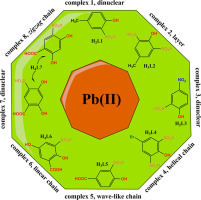Journal of Solid State Chemistry ( IF 3.2 ) Pub Date : 2018-03-23 , DOI: 10.1016/j.jssc.2018.03.025 Guo-Zhen Huang , Xin Zou , Zhi-Biao Zhu , Zhao-Peng Deng , Li-Hua Huo , Shan Gao

|
The reaction of Pb(II) salts and mono- or disulfonates leads to the formation of eight new Pb(II)-mono/disulfonate complexes, [Pb(L1)(H2O)]2 (1), [Pb4(L2)2(AcO)2]n·5nH2O (2), [Pb(L3)(H2O)]2 (3), [Pb(HL4)(H2O)2]n·nH2O (4), [Pb(HL5)(H2O)2]n·2nH2O (5), [Pb(H2L6)(H2O)]n·nDMF·2nH2O (6), [Pb2(H3L7)4(H2O)6]·2H2O (7) and [Pb(H2L7)(H2O)]n·nH2O (8) (H2L1= 2-hydroxy-5-methyl-benzenesulfonic acid, H3L2= 2-hydroxyl-5-methyl- 1,3-benzenedisulfonic acid, H2L3= 2-hydroxy-5-nitro-benzenesulfonic acid, H3L4= 2-hydroxyl-5-bromo-1,3- benzenedisulfonic acid, H3L5= 2-hydroxyl-5-carboxyl-benzenesulfonic acid, H4L6= 2,5-dihydroxyl-3-carboxyl- benzenesulfonic acid, H4L7= 2,4-dihydroxyl-5-carboxyl-benzenesulfonic acid, DMF = N,N’-dimethyl-formamide, AcO- = acetate), which have been characterized by elemental analysis, IR, TG, PL, powder and single-crystal X-ray diffraction. In view of the primary Pb–O bonds, these eight complexes exhibit diverse dinuclear (1, 3 and 7), helical chain (4), wave-like chain (5), linear chain (6), zigzag chain (8) and layer structure (2), in which the Pb(II) cations present different hemi-directed geometries. Taking the secondary Pb–O bonds into account, chain structure for complex 7, layer motifs for complexes 1 and 3–6, as well as 3-D framework for complex 8 are observed with Pb(II) cations showing more intricate holo-directed geometries. The various coordination modes of these seven different mono/disulfonate anions are responsible for the formation of these multiple structures. Furthermore, the introduction of hydroxyl and carboxyl groups increases the coordination ability of sulfonate to the p-block metal cation. Luminescent analyses indicate that complex 7 presents purple emission at 395 nm at room temperature.
中文翻译:

次级Pb-O键合支持的Pb(II)-磺酸盐配合物的合成与表征
Pb(II)盐与单或二磺酸盐的反应导致形成八个新的Pb(II)-单/二磺酸盐络合物[Pb(L1)(H 2 O)] 2(1),[Pb 4(L2)2(AcO)2 ] n ·5nH 2 O(2),[Pb(L3)(H 2 O)] 2(3),[Pb(HL4)(H 2 O)2 ] n ·nH 2 O (4),[Pb(HL5)(H 2 O)2] n ·2nH 2 O(5),[Pb(H 2 L6)(H 2 O)] n ·nDMF·2nH 2 O(6),[Pb 2(H 3 L7)4(H 2 O)6 ] ·2H 2 O(7)和[Pb(H 2 L7)(H 2 O)] n ·nH 2 O(8)(H 2 L1 = 2-羟基-5-甲基-苯磺酸,H 3L2 = 2-羟基-5-甲基-1,3-苯二磺酸,H 2 L3 = 2-羟基-5-硝基苯磺酸,H 3 L4 = 2-羟基-5-溴-1,3-苯二磺酸,H 3 L5 = 2-羟基-5-羧基-苯磺酸,H 4 L6 = 2,5-二羟基-3-羧基-苯磺酸,H 4 L7 = 2,4-二羟基-5-羧基-苯磺酸, DMF = N,N'-二甲基甲酰胺,ACO -=醋酸盐),已通过元素分析,IR,TG,PL,粉末和单晶X射线衍射进行了表征。鉴于主的Pb-O键的,这八个配合物表现出不同的双核(1,3和7),螺旋形链(4),波浪状的链(5),直链(6),Z字形链(8)和层结构(2),其中Pb(II)阳离子呈现不同的半定向几何形状。考虑到次级Pb–O键,复合物7的链结构,复合物1和3–6的层基序,以及配合物8的3-D骨架,Pb(II)阳离子显示出更复杂的全向几何结构。这七个不同的单/二磺酸根阴离子的各种配位模式负责这些多重结构的形成。此外,羟基和羧基的引入增加了磺酸盐对p-嵌段金属阳离子的配位能力。发光分析表明,在室温下,配合物7在395 nm处呈现紫色发射。









































 京公网安备 11010802027423号
京公网安备 11010802027423号